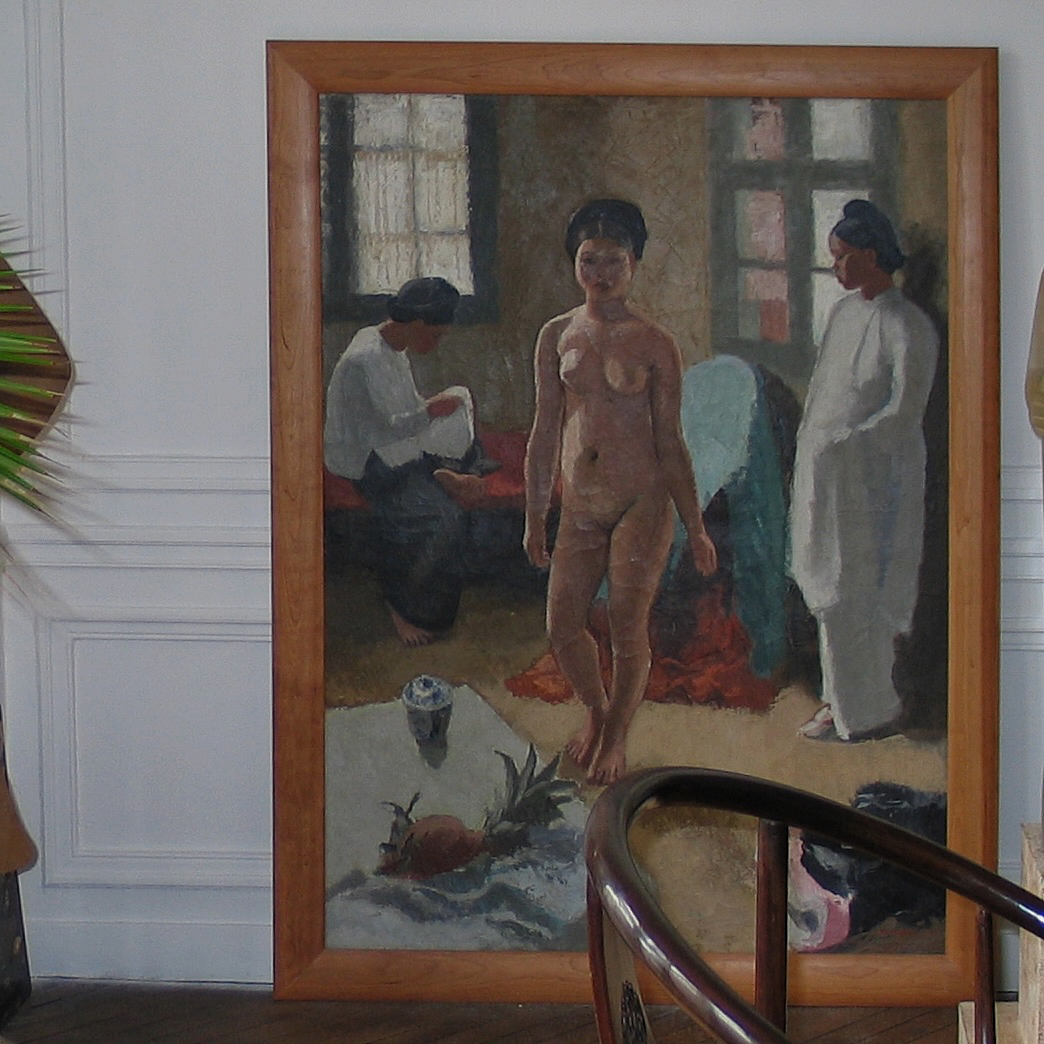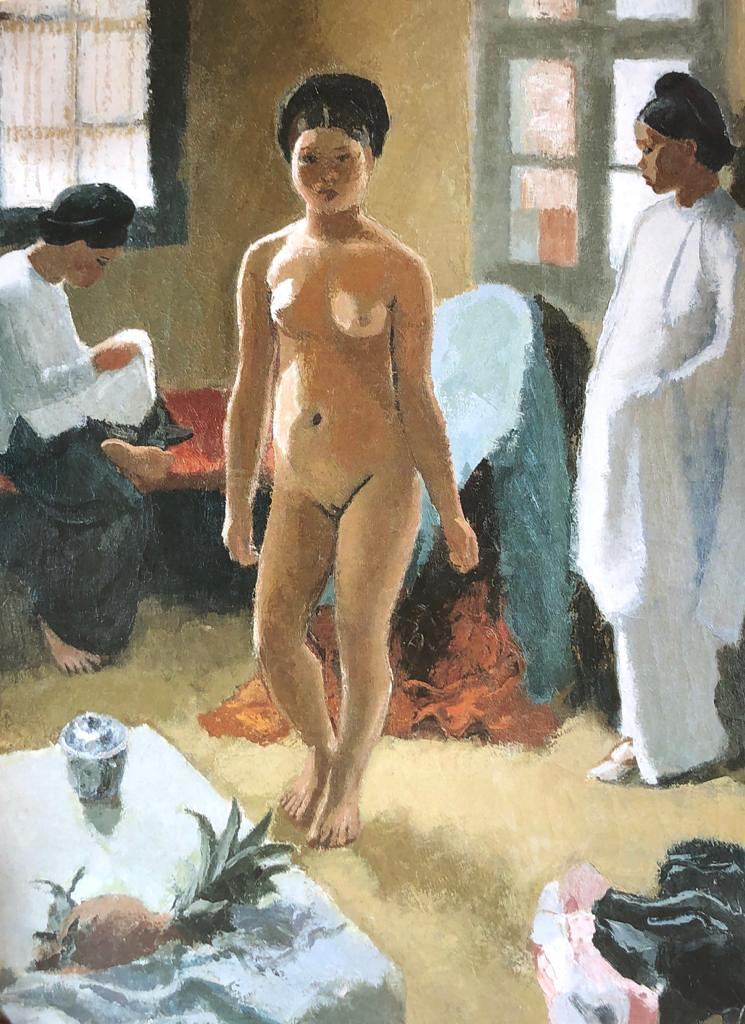
Joseph Inguimberty (France, 1896-1971)
Femme à l'Ananas (Lady with a Pineapple)
oil on canvas
146 x 108.5 cm. (57 1/2 x 42 3/4 in.)
Painted in 1934
Provenance
Private Collection, Paris, France
Acquired from the above by the present owner in 1989
Private Collection, Europe
Exhibited
Galerie Charpentier, Paris, France, 1936.
Musée Royal de Mariemont, Morlanwelz, Belgium
La Fleur du pêcher et l'oiseau d'azur- Arts et civilisations de Vietnam, 20 April - 18 August 2002

When Joseph Inguimberty arrived in Vietnam in 1925, could he possibly imagine that twenty years later he would have achieved a revolution in Vietnamese painting?
When he arrived in Vietnam, he was a 29 years old man, born in Marseille, who attended the prestigious School of Beaux-Arts (Marseille) as well as the National School of Arts décoratifs in Paris (at the age of 17) and was recognized in his work by receiving the Blumenthal prize in 1922. He was extremely sensitive to social issues: he developed a fascination for the workforce, first in Belgium during the early twenties then in Marseille between 1922 and 1924, years when he painted men working showing their significant contribution to society. "The unloading of peanuts",painted in 1922 or "Marseille" painted in 1924 are very telling of that strong influence.
This is a man who at the age of 21, suffered injuries during the first world war (1914-1918) therefore very aware of the tragedy of the world and its evanescence. Under the aegis of Victor Tardieu and with the help of Nam Son, he became a key factor to the success of the Fine Art School of Indochina, created just a few months before his arrival, this institution will leave a mark for ever on Asian painting in the XXth century.
From 1925 to 1945, so many brilliant painters paid their deepest respect to their outstanding teachers. He had his favourite students, early on with To Ngoc Van and later with Nguyen Gia Tri, among many others. He keeps teaching oil technics, but as for the teaching of lacquers, he goes beyond and transforms this decorative art into a true creative process. With the help of Alix Aymé, he was a relentless teacher committed to the great success of Vietnamese lacquer during the XXth century.
Despite all, Inguimberty would bring all his students to absorb and acquire very fundamental knowledge through classes on art history, and the anatomy of the human body emphasizing on the study of nudes. It is agreed among teachers and students that the study of nudes is the most challenging subject: no weakness in the artist’s work could be hidden by ornamentations or decor.
At the time Vietnam was very traditional, and the school’s practice confronted the strong moral standards of the country including prudery. No students or visitors could accept to pose as a model… and Victor Tardieu finally had to resort to prisoners who were punctually allowed out to exchange a few hours of modelling in front of attentive students for some extra comfort…
Through his work, Joseph Inguimberty evolved to become an outstanding teacher and a known artist: he became the great French master of Vietnam. Over all these years, in his passionate love and his educated look irresistibly charmed by Vietnam and its people, he will manage to transcend us.
"Woman with a Pineapple" was exhibited in Paris in 1936 and attracted much attention: Inguimberty is not just a "travel painter", a foreigner but a painter describing "his" land. In art, it is a fact, that land rights take precedence over blood rights.
Pierre Gourou, a very well-known French geographer and a specialist of Tonkin, describes (in "Le Monde Colonial Illustré") the painting in these terms:
"A nude figure, painted against the light in a well-lit workshop; the light floods in through the windows and eats away the outline of the character; in the foreground, a camp bed, a pineapple, black satin pants with a pink belt are thrown on the floor: each element brought together to create a harmony of colours in penetrating poetry."
He omits to mention the china-covered pot in "bleu de Hué" a telling detail showing we are in the master’s house.
This painting remains a mystery. Who is this very beautiful young lady posing with determination and no lewdness at all? She wears her Tonkinese headdress, it seems almost incongruous here. Is there any symbolism in the beauty of the nourishing pineapple which of course will soon turn bad? How much intimacy is between her and the two ladies in the background? No one can tell.
On the other hand, the magnificent light captured is revealing and unique to Inguimberty, even among his Vietnamese peers. Pierre Gourrou adds:
"No one better than him could restitute this tropical light, so different to ours, this bright light, implacable, painful to the eyes, metallic, his white dazzling skies, the acidity in the greens during the wet season, a powerful vibration you can’t find in our latitudes."
This artist is truly a genius who can capture the slightest nuances a little less evident in this room flooded with sunlight.
A profoundly novative painting, executed in Hanoi in 1934, is purely Vietnamese, as otherness doesn’t mean foreign origin. "Femme à l’Ananas" is a major masterpiece of the XXth century Vietnamese painting through the theme strong and at the same time subtle, perfected technics and the unique style which it’s a strong theme but subtle at the same time, it’s perfect technic, it’s a unique style, which contributes to an overall visual vivaciousness in the arts of the XXth century Vietnam.
Jean-François Hubert
Christie's Senior Expert, Art of Vietnam










